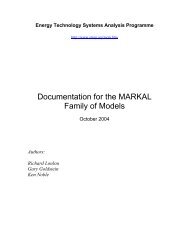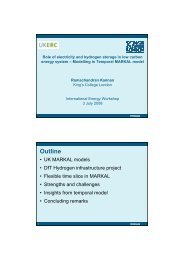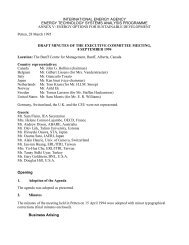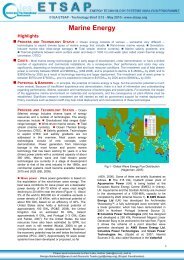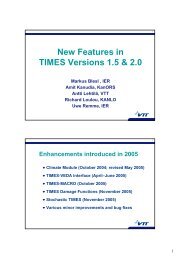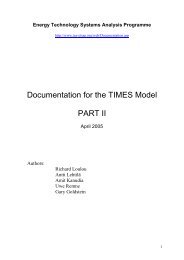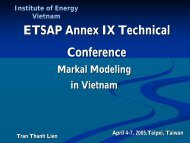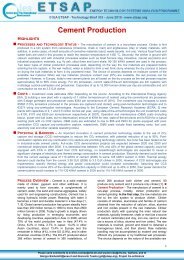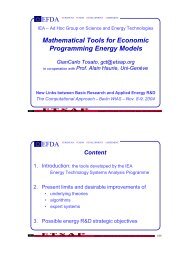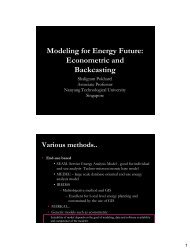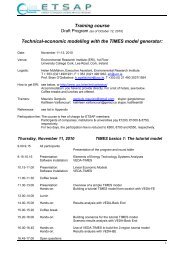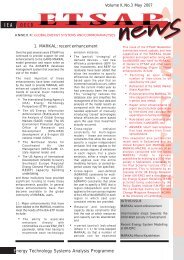Transport Modal choice in a TIMES model - iea-etsap
Transport Modal choice in a TIMES model - iea-etsap
Transport Modal choice in a TIMES model - iea-etsap
Create successful ePaper yourself
Turn your PDF publications into a flip-book with our unique Google optimized e-Paper software.
<strong>Modal</strong> <strong>choice</strong> <strong>in</strong> a <strong>TIMES</strong> <strong>model</strong><br />
Report submitted to IEA-ETSAP, May 2012<br />
Hannah Daly a , Kalai Ramea b , Alessandro Chiodi c , Sonia Yeh d , Maurizio Gargiulo e ,<br />
Brian P. Ó Gallachóir f<br />
a<br />
Environmental Research Institute,<br />
University College Cork,<br />
Cork, Ireland<br />
Email: h.e.daly@umail.ucc.ie<br />
b<br />
Institute of <strong>Transport</strong> Studies,<br />
University of California, Davis,<br />
U.S.A.<br />
Email: kramea@ucdavis.edu<br />
c<br />
Environmental Research Institute,<br />
University College Cork,<br />
Cork, Ireland<br />
Email: chiodiale@gmail.com<br />
d<br />
Institute of <strong>Transport</strong> Studies,<br />
University of California, Davis,<br />
U.S.A.<br />
Email: slyeh@ucdavis.edu<br />
e<br />
e4sma s.r.l.<br />
Via Livorno, 60 – Environment Park,<br />
I-10144 Tur<strong>in</strong>, Italy<br />
Email: maurizio.gargiulo@e4sma.com<br />
f<br />
Environmental Research Institute,<br />
University College Cork,<br />
Cork, Ireland<br />
Email: b.ogallachoir@ucc.ie<br />
1
Summary<br />
Climate change mitigation clearly requires a focus on transport that should <strong>in</strong>clude<br />
improved representation of travel behavior change <strong>in</strong> addition to <strong>in</strong>creased vehicle<br />
efficiency and low-carbon fuels. Most available energy/ economy/ environment<br />
<strong>model</strong>l<strong>in</strong>g tools focus however on technology and fuel switch<strong>in</strong>g and tend to poorly<br />
<strong>in</strong>corporate travel behavior. The objective of this research project was to <strong>in</strong>corporate<br />
modal <strong>choice</strong> with<strong>in</strong> passenger transport <strong>in</strong> a <strong>TIMES</strong> <strong>model</strong>, which to date has been<br />
exogenously <strong>model</strong>led, so that no competition exists between alternative modes. This<br />
report <strong>in</strong>troduces a novel approach to <strong>model</strong>l<strong>in</strong>g modal <strong>choice</strong> <strong>in</strong> <strong>TIMES</strong>.<br />
In typical <strong>TIMES</strong> <strong>model</strong>s, <strong>in</strong>dividual modal travel demand is exogenously def<strong>in</strong>ed<br />
over the <strong>model</strong> time horizon and while technologies can compete with<strong>in</strong> modes on the<br />
basis of cost (fuel costs, <strong>in</strong>vestment costs and O&M costs), there is no competition<br />
between modes. We built a simple illustrative <strong>TIMES</strong> <strong>model</strong>, <strong>in</strong> which future overall<br />
travel demand is exogenously def<strong>in</strong>ed but not specified by <strong>in</strong>dividual mode. We<br />
allowed competition between modes and imposed a constra<strong>in</strong>t on overall travel time<br />
<strong>in</strong> the system. This constra<strong>in</strong>t represents the empirically observed travel time budget<br />
(TTB) of <strong>in</strong>dividuals, constra<strong>in</strong><strong>in</strong>g the <strong>model</strong> choos<strong>in</strong>g between between faster and<br />
more expensive modes (e.g. cars) and slower but cheaper mode (e.g. buses or rail).<br />
<strong>Transport</strong> studies suggest that people spend, on average, a fixed amount of their daily<br />
time budget on travel irrespective of <strong>in</strong>come or location. We further <strong>in</strong>troduced a new<br />
variable, called travel time <strong>in</strong>vestment (TTI), which acts as a proxy for <strong>in</strong>frastructure<br />
<strong>in</strong>vestments (for example, new bus services or rail l<strong>in</strong>es) to reduce the time associated<br />
with travel.<br />
We populated the <strong>model</strong> with data from California, US and from Ireland and<br />
generated results to 2020 for a reference scenario, an <strong>in</strong>vestments scenario and a CO2<br />
emissions reduction scenario. The results show the significance of modal shift<strong>in</strong>g <strong>in</strong><br />
the CO2 mitigation scenario.<br />
2
1 Introduction<br />
1.1 Background<br />
<strong>Transport</strong>ation contributes to 23% of energy-related CO 2 emissions globally. With<br />
<strong>in</strong>creas<strong>in</strong>g demands especially for light-duty vehicles, freight, and aviation, global<br />
transport CO 2 emissions are expected to double by 2050 (IEA 2011). Reduc<strong>in</strong>g<br />
greenhouse gas emissions from the transport sector will require complementary<br />
policies <strong>in</strong> improv<strong>in</strong>g the efficiency of vehicles, <strong>in</strong>troduc<strong>in</strong>g low-carbon fuels and<br />
advanced vehicles technologies, and better travel demand management (Schäfer,<br />
Heywood et al. 2009; Sk<strong>in</strong>ner, Essen et al. 2010). Most of the growth <strong>in</strong> demand for<br />
cars will come from develop<strong>in</strong>g countries, as car travel <strong>in</strong> developed countries<br />
essentially saturated, and is projected to rema<strong>in</strong> flat <strong>in</strong> the next few decades (IEA<br />
2010). On the other hand, public transit and aviation already play an important role <strong>in</strong><br />
many developed (especially Europe) and develop<strong>in</strong>g countries (Figure 1). The<br />
importance of their role is expected to cont<strong>in</strong>ue to <strong>in</strong>crease given the need to<br />
drastically reduce on-road transportation emissions <strong>in</strong> order to meet str<strong>in</strong>gent climate<br />
targets (Figure 1) (Fulton, Cazzol et al. 2009; IEA 2010).<br />
However, while most of the <strong>in</strong>tegrated assessment (IA) <strong>model</strong>s that governments rely<br />
on for develop<strong>in</strong>g climate mitigation policies have been able to project portfolios of<br />
advanced fuels and vehicle technologies given climate goals, most of these <strong>model</strong>s are<br />
ill suited to exam<strong>in</strong>e potential travel demand changes and travel mode shifts given<br />
climate policies and changes <strong>in</strong> fuel prices, and most importantly the necessary<br />
<strong>in</strong>vestments needed to reduce vehicle travel, <strong>in</strong>crease public transit shares, and nonvehicle<br />
<strong>in</strong>frastructure given climate goals (Schäfer 2012). Most IA <strong>model</strong>s use<br />
scenario describ<strong>in</strong>g future travel mode shifts without explicitly l<strong>in</strong>k<strong>in</strong>g demand<br />
changes to drivers (e.g. fuel price changes) or <strong>in</strong>frastructure and technology<br />
<strong>in</strong>vestment decisions. This is evident <strong>in</strong> Figure 1 and other studies (Fulton, Cazzol et<br />
al. 2009; IEA 2010; Sk<strong>in</strong>ner, Essen et al. 2010).<br />
3
Figure 1: Relative share of transport modes <strong>in</strong> the three metaregions and the world, <strong>in</strong> history<br />
(1950 and 2005) and <strong>in</strong> projections (2050) based on various scenarios. SRES-B1: Special Report<br />
on Emissions Scenarios – SRES, rapid economic growth and advanced technology scenario.<br />
EPPA-RR: MIT Emissions Prediction and Policy Analysis (EPPA) CGE <strong>model</strong>. Source: (Schäfer,<br />
Heywood et al. 2009).<br />
A recent sem<strong>in</strong>al paper by Schäfer (2012) provides a critical review of the (lack of)<br />
<strong>model</strong>l<strong>in</strong>g of behavioral changes <strong>in</strong> transportation <strong>in</strong> energy/economy/environment<br />
(3E) <strong>model</strong>s, compares common methodologies employed <strong>in</strong> IA <strong>model</strong>s, their<br />
shortcom<strong>in</strong>gs and gives recommendations for future improvement. This paper states<br />
that “Overall, <strong>in</strong>troduc<strong>in</strong>g behavioral change <strong>in</strong> transportation <strong>in</strong>to E3 <strong>model</strong>s is<br />
feasible and <strong>in</strong>tellectually reward<strong>in</strong>g. However, when pursu<strong>in</strong>g holistic approaches to<br />
mitigat<strong>in</strong>g energy use and emissions, it is <strong>in</strong>dispensable.” Our paper explores some of<br />
the recommended methologies and applies them for the first time <strong>in</strong> a bottom-up<br />
optimization <strong>model</strong><strong>in</strong>g framework us<strong>in</strong>g the <strong>TIMES</strong> <strong>model</strong> and implements this <strong>in</strong><br />
two case study based on the Californian <strong>TIMES</strong> <strong>model</strong> and the Irish <strong>TIMES</strong> <strong>model</strong>.<br />
We will describe the <strong>TIMES</strong> <strong>model</strong><strong>in</strong>g framework and review the role of transport <strong>in</strong><br />
energy <strong>model</strong>s and key underly<strong>in</strong>g concepts of travel behaviors <strong>in</strong> Section 1.2,<br />
describe our methodology <strong>in</strong> Section 2, compare data and describe sources of the case<br />
studies <strong>in</strong> Section 3, present results <strong>in</strong> Section 4 and conclude <strong>in</strong> Section 5.<br />
4
1.2 <strong>Transport</strong> <strong>in</strong> energy systems <strong>model</strong>s<br />
<strong>Transport</strong> <strong>model</strong>l<strong>in</strong>g is a very well established discipl<strong>in</strong>e used widely by decisionmakers<br />
for plann<strong>in</strong>g <strong>in</strong>frastructure such as airports, roads and railways, for costbenefit<br />
analyses, and environmental impact assessments. <strong>Transport</strong> plann<strong>in</strong>g <strong>model</strong>s<br />
typically simulate travel trips by orig<strong>in</strong> and dest<strong>in</strong>ation, trip purpose, mode of travel<br />
and household demographies. Mode <strong>choice</strong> computes the proportion of trips between<br />
each orig<strong>in</strong> and dest<strong>in</strong>ation is often <strong>model</strong>led us<strong>in</strong>g by a logit type <strong>model</strong> (de Dios<br />
Ortúzar and Willumsen 2001). Behaviour is generally a strong element of these<br />
<strong>model</strong>s, whereas there is generally very little or no treatment of energy demand.<br />
On the other hand, Energy/Environment/Economy (E3) <strong>model</strong>s explicitly look at the<br />
energy system to exam<strong>in</strong>e issues rang<strong>in</strong>g from macroeconomic <strong>in</strong>teractions to look<strong>in</strong>g<br />
at pathways to meet<strong>in</strong>g climate mitigation scenarios. Schäfer (2012) describes how<br />
transport is represented <strong>in</strong> a range of these <strong>model</strong>s, <strong>in</strong> particular exam<strong>in</strong><strong>in</strong>g the role of<br />
behaviour <strong>in</strong> transport, which is necessarily more constra<strong>in</strong>ed <strong>in</strong> energy <strong>model</strong>s.<br />
The <strong>TIMES</strong> <strong>model</strong>, used to implement the approach described here, is a bottom-up<br />
energy systems <strong>model</strong> developed by the Energy Technology Systems Analysis<br />
Programme (ETSAP), an IEA Implement<strong>in</strong>g Agreement (Ó Gallachóir et. al. 2012).<br />
Energy systems <strong>model</strong>s like <strong>TIMES</strong> are generally partial equilibrium l<strong>in</strong>ear<br />
optimisation <strong>model</strong>s, with very rich technological detail of the entire energy system,<br />
from fuel production and imports to energy conversion and demand technologies. The<br />
total system cost is m<strong>in</strong>imised over a time horizon subject to user-def<strong>in</strong>ed constra<strong>in</strong>ts,<br />
such as maximum system-wide CO 2 emissions. Demands are generally exogenously<br />
projected, and can be derived from other <strong>model</strong>s. A facility for elastic demand is<br />
available <strong>in</strong> <strong>TIMES</strong>, where end-use can be a function of price or <strong>in</strong>come. Schäfer<br />
(2012) gives a number of examples of such <strong>model</strong>s, none of which consider<br />
behaviour. Because technology selection <strong>in</strong> these <strong>model</strong>s is determ<strong>in</strong>ed by the least<br />
system cost, and travel behaviour is largely dictated by user costs, which can <strong>in</strong>clude<br />
time costs and barrier costs, it has been difficult to <strong>model</strong> realistic modal <strong>choice</strong><br />
behaviour <strong>in</strong> these <strong>model</strong>s. Mode <strong>choice</strong> is therefore typically exogenous, which is a<br />
significant limitation, given that this is considered to be an important step <strong>in</strong> mov<strong>in</strong>g<br />
towards susta<strong>in</strong>able mobility (Banister 2008).<br />
5
Other types of E3 <strong>model</strong>s <strong>in</strong>clude hybrid and top-down approaches, which, because<br />
the <strong>model</strong>l<strong>in</strong>g approaches are not strictly l<strong>in</strong>ear optimisation, typically have more<br />
flexible and nuanced representations of travel demand, but not such a detailed<br />
representation of energy technologies as bottom-up <strong>model</strong>s. The hybrid <strong>model</strong>s<br />
<strong>in</strong>clude the Global Change Assessment Model (GCAM) <strong>model</strong>, developed at the<br />
Pacific Northwest National Laboratory, which is a general equilibrium <strong>model</strong> which<br />
solves for prices, supply and demand for all markets. Mode <strong>choice</strong> is <strong>model</strong>ed us<strong>in</strong>g a<br />
logit <strong>model</strong> approach, where the cost of time is <strong>in</strong>cluded <strong>in</strong> the generalized cost for<br />
transport, and so <strong>in</strong>creases <strong>in</strong> GDP leads to a demand for faster modes. The Canadian<br />
Integrated Modell<strong>in</strong>g System (CIMS) also <strong>in</strong>cludes a logit sub-<strong>model</strong> for mode and<br />
fuel <strong>choice</strong>. A third hybrid <strong>model</strong> with transport behaviour is IMACLIM-R (IMpact<br />
Assessment of CLIMate policies-Recursive version), developed at CIRED, which<br />
maximizes a utility function subject to travel budget constra<strong>in</strong>ts. Infrastructure is<br />
endogenous: a decrease <strong>in</strong> supply leads to congestion and lower speeds, which feeds<br />
back <strong>in</strong>to the <strong>model</strong>.<br />
Constra<strong>in</strong><strong>in</strong>g overall travel time <strong>in</strong> this latter <strong>model</strong> is the essence of the contribution<br />
of this paper to <strong>model</strong>l<strong>in</strong>g travel behaviour <strong>in</strong> bottom-up energy systems <strong>model</strong>s. It<br />
has been empirically observed that the average daily travel time is constant across<br />
many different populations (Marchetti 1994) (Gakenheimer 1999). Figure 2 shows<br />
results from the UK National Travel Survey (NTS) on travel patterns s<strong>in</strong>ce 1970. It<br />
shows that while total travel distance has grown by approximately 60% <strong>in</strong> the period,<br />
total annual travel time per person has stayed constant. This has <strong>in</strong>troduced the<br />
concept of a fixed travel time budget (TTB), which is <strong>in</strong>variant under policy and<br />
economics. Schäfer and Victor (2000) use this TTB of 1.1 hours per day along with a<br />
fixed travel money budget to project future levels of mobility and transport mode.<br />
This paper also follows this approach, which is consistent with the l<strong>in</strong>ear<br />
programm<strong>in</strong>g approach adopted.<br />
6
Figure 2: Travel time (hours per person per year), distance (miles pppy) and journeys (pppy) <strong>in</strong><br />
the UK. Source: (Metz 2010)<br />
2 Methodology<br />
This section describes the basic <strong>model</strong> structure of the methodology and its<br />
implementation <strong>in</strong> a simple illustrative <strong>TIMES</strong> <strong>model</strong>. In this <strong>model</strong>, different<br />
transport modes compete on the basis of fuel and capital costs to deliver overall travel<br />
demand, while a constra<strong>in</strong>t on overall travel time <strong>in</strong> the system, represent<strong>in</strong>g the travel<br />
time budget (TTB) of <strong>in</strong>dividuals, ensures that faster and more expensive modes can<br />
also compete. We <strong>in</strong>troduce a new variable, travel time <strong>in</strong>vestment (TTI), a proxy for<br />
<strong>in</strong>vestments to reduce the time associated with travel. This <strong>model</strong> is then tested under<br />
a reference scenario (to 2020), an <strong>in</strong>vestment scenario and a CO 2 emissions reduction<br />
scenario.<br />
2.1 Model structure<br />
Motorised travel demand is represented by person miles travelled (PMT), which is the<br />
sum of demands of car (CMT), bus (BMT) and tra<strong>in</strong> (TMT). PMT for a technology is<br />
given by the vehicle miles travelled (VMT) multiplied by the load factor (LF, or<br />
occupancy of the vehicle). PMT is divided by long and short distance demand (PMT L<br />
and PMT S ) <strong>in</strong> order to capture the characteristics of the different technologies<br />
servic<strong>in</strong>g the different demands: High-speed tra<strong>in</strong> and buses can service long distance<br />
7
travel, while city buses can service short distance; cars serve both. Furthermore, the<br />
speed of technologies serv<strong>in</strong>g long and short distance differs significantly: For<br />
example, for longer distance a rail trips, the required wait<strong>in</strong>g time is absorbed by the<br />
speed of the overall journey and is more significant <strong>in</strong> shorter trips.<br />
The <strong>model</strong> is based on a least-cost l<strong>in</strong>ear programm<strong>in</strong>g approach. It determ<strong>in</strong>es<br />
PMT t,d , the travel demand for long and short distance (d) of each of the technologies<br />
(t) such that the overall system cost is m<strong>in</strong>imised. The cost of technology activity, c t,d<br />
is the cost <strong>in</strong> $/PMT of travel <strong>in</strong> each technology produc<strong>in</strong>g long or short distance<br />
travel demand d, given by the sum of the fuel, <strong>in</strong>vestment and O&M costs <strong>in</strong> dollars<br />
per PMT.<br />
The <strong>model</strong> is constra<strong>in</strong>ed to meet annual short- and long-distance travel demand,<br />
which are <strong>model</strong>led exogenously and can be based on the output of transport <strong>model</strong>s,<br />
for example.<br />
The concept of a travel time budget (TTB <strong>in</strong> million hours, mhs) is <strong>in</strong>troduced to the<br />
<strong>model</strong> to represent the empirically observed fixed travel time per-capita <strong>in</strong> the real<br />
world, as described <strong>in</strong> Section 1. This enables competition between different transport<br />
modes based on travel time <strong>in</strong> addition to cost. Without this the <strong>model</strong> will be likely<br />
to switch modes immediately to the cheaper but slower and more time-costly public<br />
transit modes, which doesn’t reflect travel behaviour. Previous <strong>TIMES</strong> <strong>model</strong>s <strong>in</strong><br />
general have fixed travel demand for each mode, and while allow technologies to<br />
compete with<strong>in</strong> modes, but not between modes.<br />
Ideally, speed and <strong>in</strong>frastructure would be endogenous to the <strong>model</strong>, so that the <strong>model</strong><br />
could <strong>in</strong>vest <strong>in</strong>to decreas<strong>in</strong>g travel time. We <strong>in</strong>troduce a variable TTI (travel time<br />
<strong>in</strong>vestment) which is a proxy to endogenise this relationship.<br />
The <strong>model</strong> determ<strong>in</strong>es PMT t,d and tti t,d subject to:<br />
M<strong>in</strong>imise C PMT t,d<br />
c t,d , (Equation 1)<br />
t,d<br />
where PMT t,d is the travel demand of technology t for long or short demand d and cost<br />
is the sum of fuel, <strong>in</strong>vestment, O&M and TTI cost:<br />
8
c t,d<br />
f t,d<br />
i t,d<br />
om t,d<br />
tc t,d ; (Equation 2)<br />
where fuel cost f t,d is a product of the price per unit of energy of fuel and the energy<br />
<strong>in</strong>tensity by technology, divided by the load factor:<br />
f t,d<br />
(F <strong>in</strong>t t,d<br />
) LF; (Equation 3)<br />
and the cost of travel time <strong>in</strong>vestment tti t,d depends on vehicle speed:<br />
tc t,d<br />
(tti t,d<br />
s t,d<br />
) i (Equation 4)<br />
where s t,d is the speed <strong>in</strong> miles per hour of technologies and i is the TTI cost;<br />
The <strong>model</strong> is subject to the constra<strong>in</strong>ts:<br />
PMT t,d<br />
PMT d for long and short demand d (Equation 5)<br />
t<br />
and<br />
<br />
<br />
tti t,d TTB<br />
(Equation 6)<br />
<br />
<br />
t,d<br />
PMT t,d<br />
s t,d<br />
We may also constra<strong>in</strong> the <strong>model</strong> to meet a CO 2 target X:<br />
PMT t,d<br />
e t,d<br />
X<br />
(Equation 7)<br />
t,d<br />
where e t,d is the emissions <strong>in</strong> gCO 2 /PMT of each technology, which is given by the<br />
fuel emissions factor, technology efficiency and mode load factor.<br />
2.2 <strong>TIMES</strong> Implementation<br />
2.2.1 <strong>Transport</strong> Reference Energy System<br />
In <strong>TIMES</strong> <strong>model</strong>s the transport sector typically comprises a stock of technologies, <strong>in</strong><br />
competition, that contribute to meet each exogenously def<strong>in</strong>ed modal travel demand<br />
(<strong>in</strong> passenger miles travelled–PMT or passenger kilometres travelled–PKT). Figure 3<br />
shows an example of this approach <strong>in</strong> the form of Reference Energy System extracted<br />
from current Irish <strong>TIMES</strong> passenger transport sector (Ó Gallachóir et.al. 2012). An<br />
equivalent structure characterizes the CA-<strong>TIMES</strong> <strong>model</strong>.<br />
9
Figure 3 – Reference Energy System for Irish <strong>TIMES</strong> passenger travel sector. Here technologies<br />
can compete with<strong>in</strong> modes but not between modes.<br />
With<strong>in</strong> the new Reference Energy System, as shown <strong>in</strong> Figure 4, we <strong>in</strong>troduce just<br />
two travel demand commodities: long distance demand (TLDD) and short distance<br />
demand (TSDD) expressed <strong>in</strong> PMT/year. In order to produce energy service demands<br />
all technologies such cars, tra<strong>in</strong>s and buses have two <strong>in</strong>puts: the fuel <strong>in</strong>put and the<br />
time <strong>in</strong>put. Here the TIME <strong>in</strong>put describes the travel time from orig<strong>in</strong> to dest<strong>in</strong>ation,<br />
which is dependent on the modal speed, wait<strong>in</strong>g and transfer time. This depends on<br />
technology, <strong>in</strong>frastructure, reliability, congestion, accessibility, etc. The Travel Time<br />
Budget (TTB) is exogenously def<strong>in</strong>ed <strong>in</strong> a similar way to demand growth. The <strong>model</strong><br />
uses Travel Time Investment (TTI) as discussed <strong>in</strong> Section 2.1.<br />
10
TIME Fuels Demands (PMT)<br />
Time<br />
Electricity<br />
Fossil<br />
Long Distance<br />
Short Distance<br />
……<br />
CARS<br />
MINTTB<br />
……<br />
BUSES City<br />
MINTTI1<br />
……<br />
……<br />
BUSES<br />
InterCity<br />
[...]<br />
……<br />
METRO/TRAM<br />
MINTTIn<br />
……<br />
……<br />
TRAINS<br />
……<br />
……<br />
PLANES<br />
Figure 4 – Proposed Reference Energy System<br />
2.2.3 How to implement the VEDA-<strong>TIMES</strong> <strong>model</strong><br />
The VEDA-<strong>TIMES</strong> <strong>model</strong> implementation <strong>in</strong>cludes commodity and process<br />
def<strong>in</strong>itions as always. This <strong>model</strong> <strong>in</strong>cludes the follow<strong>in</strong>g commodities, as shown <strong>in</strong><br />
Figure 5:<br />
- Fossil fuels (NRG type) <strong>in</strong> PJ;<br />
- Travel TIME (NRG type) <strong>in</strong> Mhs (Million hours);<br />
- Long and Short distance demand (DEM type) <strong>in</strong> PMT (Person Miles<br />
Travelled)<br />
- Emissions of CO2 (ENV type) <strong>in</strong> kton.<br />
11
Commodities<br />
~FI_Comm<br />
Csets Region CommName CommDesc Unit<br />
*Commodity Set<br />
Membership Region Name Commodity Name Commodity Description Unit<br />
NRG TRAOIL <strong>Transport</strong> fossil fuels PJ<br />
TRAELC <strong>Transport</strong> electricity PJ<br />
DEM TSDD <strong>Transport</strong> Short Distance demand PMT<br />
TLDD <strong>Transport</strong> Long distance demand PMT<br />
ENV TRACO2 <strong>Transport</strong> CO2 kt<br />
NRG TIME Time commodity Mhs<br />
Figure 5 – Commodity def<strong>in</strong>ition<br />
With<strong>in</strong> the new Reference Energy System, as shown <strong>in</strong> Figure 4, we <strong>in</strong>troduce just<br />
two travel demand commodities: long distance demand (TLDD) and short distance<br />
demand (TSDD) expressed <strong>in</strong> PMT/year. In order to produce energy service demands<br />
all technologies such cars, tra<strong>in</strong>s and buses have two <strong>in</strong>puts: the fuel <strong>in</strong>put and the<br />
time <strong>in</strong>put. Here the TIME <strong>in</strong>put describes the travel time from orig<strong>in</strong> to dest<strong>in</strong>ation,<br />
which is dependent on the modal speed, wait<strong>in</strong>g and transfer time.<br />
The TIME <strong>in</strong>put is produced by TTB and TTI m<strong>in</strong><strong>in</strong>g processes at different prices.<br />
The TIME commodity availability is the sum of MINTTB output and MINTTIn<br />
outputs.<br />
The <strong>model</strong> <strong>in</strong>cludes the follow<strong>in</strong>g exist<strong>in</strong>g technologies, as shown <strong>in</strong> Figure 6:<br />
- Demand technologies (DMD)<br />
o Cars (short and long distance); the same car can produce both short<br />
and long distance demand but this is simulated <strong>in</strong> the <strong>model</strong> with a<br />
trick. There are two different technologies, TCARS for short and<br />
TCARL for long distance. This is necessary to implement <strong>in</strong> the <strong>model</strong><br />
different TIME <strong>in</strong>put for short and long distance.<br />
o Buses (short and long distance); there are two different buses and they<br />
can produce short (City) or long (Intercity) distance demand.<br />
o Tra<strong>in</strong>s (short and long distance); there are two different tra<strong>in</strong>s and they<br />
can produce short (City) or long (Intercity) distance demand.<br />
o <strong>Transport</strong> aviation for long distance demand.<br />
12
Processes<br />
~FI_Process<br />
Sets TechName TechDesc Tact Tcap<br />
*Process Set<br />
Membership Technology Name Technology Description Activity Unit<br />
Capacity<br />
Unit<br />
DMD TCARS1 <strong>Transport</strong> short distance car 1 PMT 000_units<br />
TCARL1 <strong>Transport</strong> long distance car 1 PMT 000_units<br />
TBUSS1 <strong>Transport</strong> City Bus short distance 1 PMT 000_units<br />
TBUSL1 <strong>Transport</strong> Intercity Bus long distance 1 PMT 000_units<br />
TTRAINS1 <strong>Transport</strong> City Tra<strong>in</strong> short distance 1 PMT 000_units<br />
TTRAINL1 <strong>Transport</strong> Intercity Tra<strong>in</strong> long distance 1 PMT 000_units<br />
TPLANEL1 <strong>Transport</strong> Aviation 1 long distance PMT 000_units<br />
MIN MINTRAOIL <strong>Transport</strong> fossil fuels Infrastructure PJ<br />
MINTRAELC <strong>Transport</strong> electricity Infrastructure PJ<br />
MINTTB Travel TIME budget availability Mhs<br />
MINTTI1 Travel TIME Investment availability 1 Mhs<br />
MINTTI2 Travel TIME Investment availability 2 Mhs<br />
MINTTI3 Travel TIME Investment availability 3 Mhs<br />
MINTTI4 Travel TIME Investment availability 4 Mhs<br />
Figure 6 – Process def<strong>in</strong>ition<br />
- M<strong>in</strong><strong>in</strong>g technologies for fuels and TIME availability (MIN). Figure 7 show<br />
how the m<strong>in</strong><strong>in</strong>g technologies are described <strong>in</strong> the <strong>model</strong>.<br />
o Oil m<strong>in</strong><strong>in</strong>g (MINTRAOIL) to generate transport oil availability <strong>in</strong> the<br />
<strong>model</strong>;<br />
o Electricity m<strong>in</strong><strong>in</strong>g (MINTRAELC) to generate transport electricity<br />
availability <strong>in</strong> the <strong>model</strong>;<br />
o TTB m<strong>in</strong><strong>in</strong>g technology for TTB availability <strong>in</strong> the <strong>model</strong>. The process<br />
output is TIME and the activity is bounded <strong>in</strong> the base year template<br />
and then updated via scenario file.<br />
o TTI m<strong>in</strong><strong>in</strong>g technologies for TTI availability and costs <strong>in</strong> the <strong>model</strong>.<br />
The processes output is TIME and the activity of each process is<br />
bounded <strong>in</strong> the base year template and updated via scenario file. The<br />
same happens for the related costs.<br />
13
~FI_T<br />
TechName Comm-OUT COST<br />
*Technology<br />
Commodity<br />
Name Output Commodity Cost<br />
*Unit<br />
M$/PJ<br />
MINTRAOIL TRAOIL 10.4<br />
MINTRAELC TRAELC 22<br />
~FI_T<br />
TechName Comm-OUT COST ACTBND<br />
*Technology<br />
Name<br />
Output Commodity<br />
Commodity<br />
Cost<br />
Commodity<br />
availability<br />
*Unit M$/mhs Mhs<br />
MINTTB TIME 0.00001 13712<br />
MINTTI1 TIME 1.00 100<br />
MINTTI2 TIME 2.00 100<br />
MINTTI3 TIME 3.00 100<br />
MINTTI4 TIME 4.00 100<br />
Figure 7 – M<strong>in</strong><strong>in</strong>g processes<br />
~FI_T<br />
TechName Comm-IN Comm-IN-A Comm-OUT Input Stock CAP2ACT EFF AFA<br />
ACTFLO~<br />
DEMO<br />
FIXOM<br />
Life<br />
*Technology Name<br />
Input<br />
Commodity<br />
Auxiliary Input<br />
Output<br />
Commodity<br />
Time<br />
consumption<br />
Exist<strong>in</strong>g Capacity to Process<br />
Capacity Activity Factor Efficiency<br />
Annual<br />
Availability<br />
Factor<br />
N.<br />
Pass/Mode<br />
Fixed O&M<br />
Cost<br />
Lifetime<br />
*Unit Mhs/MVM 000 Units MVM/PJ<br />
Max miles per<br />
vehicle per year Pass/Vehicle<br />
M$/'000<br />
Vehicles<br />
TCARS1 TRAOIL TSDD 15841 0.001 302 12302 1.67 0.16 8<br />
TIME 0.052<br />
TCARL1 TRAOIL TLDD 15841 0.001 378 2664 1.67 8<br />
TIME 0.045<br />
TBUSS1 TRAOIL TSDD 21.35 0.001 103 37523 9 4.73 20<br />
TIME 0.616<br />
TBUSL1 TRAOIL TLDD 1.41 0.001 112 37523 9 4.73 40<br />
TIME 0.588<br />
TTRAINS1 TRAOIL TSDD 0.00 0.001 9 77732 102.6 100 40<br />
TIME ‐<br />
TTRAINL1 TRAELC TLDD 0.11 0.001 7 77732 102.6 100 40<br />
TIME 4.154<br />
TPLANEL1 TRAOIL TLDD 0.00 0.001 5 100000 100 400 40<br />
TIME ‐<br />
Figure 8 – DMD processes implementation<br />
The DMD technologies implementation is shown <strong>in</strong> Figure 8Error! Reference<br />
source not found.. For buses, tra<strong>in</strong>s and planes it is a standard VEDA-<strong>TIMES</strong><br />
description with technology name, description, commodity <strong>in</strong>put, auxiliary <strong>in</strong>put to<br />
<strong>in</strong>clude the TIME commodity <strong>in</strong> the analysis, commodity output and some parameters<br />
for each technology (stock, efficiency, life, etc.).<br />
For cars, as said before we used a trick to implement different TIME <strong>in</strong>put for short<br />
and long distance demand. The trick is to <strong>in</strong>clude <strong>in</strong> the <strong>model</strong> two different cars<br />
14
technology but use the two technology as a s<strong>in</strong>gle real car. The two technologies are<br />
represented with the same Stock, Cap2Act, ActFlo and Life but with different Input<br />
for the COMM-IN-A (auxiliary TIME <strong>in</strong>put), EFF, AFA and FIXOM.<br />
The new technologies are <strong>in</strong> the SubRes workbook and are described <strong>in</strong> the same way<br />
as the exist<strong>in</strong>g technologies, except for the Start parameter, as shown <strong>in</strong> Figure 9.<br />
~FI_T<br />
TechName Comm-IN Comm-IN-A Comm-OUT START Input CAP2ACT EFF AFA<br />
*Technology Name<br />
Input<br />
Commodity<br />
Auxiliary Input<br />
Output<br />
Commodity<br />
Time<br />
consumption<br />
Capacity to<br />
Activity<br />
Factor<br />
Process<br />
Efficiency<br />
*Unit Mhs/MVM MVM/PJ<br />
Annual<br />
Availability Factor<br />
Max miles per<br />
year<br />
ACTFLO<br />
~DEMO<br />
N.<br />
Pass/Mode<br />
Pass/Vehicl<br />
e<br />
INVCOST FIXOM Life<br />
Investment<br />
Cost<br />
CUR/000_Ve<br />
hicles<br />
Fixed O&M<br />
Cost<br />
M$/'000<br />
Vehicles<br />
TCARS2 TRAOIL TSDD 2009 0.001 302 11493 1.67 23.55 0.16 15<br />
TIME 0.052<br />
TCARL2 TRAOIL TLDD 2009 0.001 378 2069 1.67 15<br />
TIME 0.045<br />
TBUSS2 TRAOIL TSDD 2009 0.001 103 37523 9 230 4.73 25<br />
TIME 0.616<br />
TBUSL2 TRAOIL TLDD 2009 0.001 112 37523 9 230 4.73 25<br />
TIME 0.588<br />
TTRAINS2 TRAOIL TSDD 2100 0.001 9 77732 102.6 5000 100 40<br />
TIME ‐<br />
TTRAINL2 TRAELC TLDD 2009 0.001 7 77732 102.6 5000 100 40<br />
TIME 4.154<br />
TPLANEL2 TRAOIL TLDD 2100 0.001 5 100000 100 20000 400 15<br />
TIME ‐<br />
Lifetime<br />
Figure 9 – New DMD processes<br />
In this case the new capacity for the cars technologies is controlled via a User<br />
Constra<strong>in</strong>ts built <strong>in</strong> a scenario file. This user constra<strong>in</strong>t (Figure 10) is forc<strong>in</strong>g the<br />
<strong>model</strong> to <strong>in</strong>stall the same capacity for TCARS2 and TCARL2.<br />
~UC_T<br />
UC_N Pset_PN Year UC_NCAP UC_RHSRTS~FX UC_RHSRTS~FX~0 UC_Desc<br />
UC_CAR_NCAP TCARS2 2009 1 0 5 Sum TCARS2 and TCARL2<br />
TCARL2 ‐1<br />
Figure 10 – User constra<strong>in</strong>t to force the same short and long distance car capacity<br />
Expert feedback:<br />
- The <strong>model</strong> could be simplified by <strong>in</strong>troduc<strong>in</strong>g the auxiliary <strong>in</strong>put as a function<br />
of the output. In this way will be possible to use two different TIME <strong>in</strong>put<br />
15
depend<strong>in</strong>g on the output commodity. Any suggestion about this possibility is<br />
welcome.<br />
3 Case studies: California and Ireland<br />
3.1 California data sources<br />
Passenger cars are predom<strong>in</strong>antly used as the preferred mode of transport <strong>in</strong><br />
California. Public transit, that <strong>in</strong>cludes all the commuter tra<strong>in</strong>s and buses <strong>in</strong> the state,<br />
comprises about 10% of the total demand (California Dept. of <strong>Transport</strong>ation 2002).<br />
The passenger miles travelled (PMT) <strong>in</strong> the state for all the modes are split between<br />
long distance and short distance demands. The short distance demands are captured<br />
from the trips with<strong>in</strong> the metropolitan areas <strong>in</strong> the state, with population greater than 1<br />
million. Table 1 lists the data sources for the attributes used <strong>in</strong> this <strong>model</strong>.<br />
Attributes<br />
Person trips by mode and average trip<br />
distances per person <strong>in</strong> each region <strong>in</strong> CA<br />
Travel time for public transit (<strong>in</strong>clud<strong>in</strong>g<br />
wait<strong>in</strong>g time and transfer time)<br />
California population estimates<br />
Source<br />
2009 National Household Travel Survey,<br />
2010 California Household Travel Survey<br />
National Highway Institute of Federal<br />
Highway Adm<strong>in</strong>istration, U.S. Bureau of<br />
<strong>Transport</strong>ation Statistics<br />
U.S. Census Bureau<br />
Load factors and availability factors for<br />
transit modes<br />
Table 1: Data Sources for the California <strong>Modal</strong> Share <strong>model</strong><br />
3.2 Ireland data sources<br />
16<br />
National Transit Database of Federal<br />
Transit Adm<strong>in</strong>istration<br />
The characterisation of Irish travel demand accord<strong>in</strong>g to passenger travel (as opposed<br />
to vehicle travel) is not available, therefore this exercise required orig<strong>in</strong>al research.<br />
For the Irish <strong>model</strong>, short distance travel demand is def<strong>in</strong>ed to be trips of 30<br />
kilometres or less. Total annual travel demand and the base-year modal split of<br />
demand by car, bus and tra<strong>in</strong> for short and long demand were derived from microdata<br />
from Ireland’s Central Statistics Office Pilot National Travel Survey (CSO 2011)<br />
conducted <strong>in</strong> 2009. This used a travel diary methodology to survey travel<br />
characteristics, <strong>in</strong>clud<strong>in</strong>g distance, mode, time and trip purpose, for a cross section of
the population. Total annual travel demand <strong>in</strong> passenger kilometres travelled (PKT)<br />
for this <strong>model</strong>l<strong>in</strong>g exercise was calculated us<strong>in</strong>g the average daily distance (by car,<br />
bus or tra<strong>in</strong>) per person for this survey. The speed of each mode for long and short<br />
distance demand was calculated as the weighted average quotient of trip distance and<br />
trip time.<br />
In order to calculate load factors for cars and buses, vehicle kilometres travelled<br />
(VKT) were used: Total private car VKT for 2008 was derived from national car test<br />
odometer read<strong>in</strong>gs (Daly and Ó Gallachóir 2011); bus VKT were sourced from the<br />
Central Statistics Office (CSO 2008). VKT for Dubl<strong>in</strong>’s light rail system (Dart and<br />
Luas) was used for short distance demand.<br />
The characteristics of transport technologies was taken from the Irish <strong>TIMES</strong> <strong>model</strong><br />
(Ó Gallachóir, Chiodi et al. 2012).<br />
3.3 Compar<strong>in</strong>g California and Ireland<br />
Figures 11-14 compare the <strong>in</strong>put data and travel characteristics for long and short<br />
distance travel for the Ireland and California <strong>model</strong>s.<br />
Figure 11: Energy <strong>in</strong>tensity (MJ/PKT)<br />
Figure 12: Operation and Ma<strong>in</strong>tenance (O&M) costs <strong>in</strong> €/PKT<br />
17
Figure 13: Investment costs (€/PKT)<br />
Figure 14: Times efficiency (<strong>in</strong>verse of travel speed) <strong>in</strong> hours/PKT<br />
4 Results<br />
The modal-share <strong>model</strong> is run for several scenarios for each region. Table 2 gives the<br />
descriptions of all the scenarios of this <strong>model</strong>l<strong>in</strong>g exercise.<br />
Scenarios<br />
No TTB limit<br />
Reference case<br />
Introduc<strong>in</strong>g TTI<br />
Description<br />
This scenario imposes no TTB constra<strong>in</strong>t. Allows competition<br />
between modes based on technology and fuel costs only.<br />
This scenario uses constant TTB per capita over the time<br />
horizon. Competition between modes is based on time <strong>in</strong><br />
addition to cost.<br />
Different levels of TTI are <strong>model</strong>led as a proxy for <strong>in</strong>vestments<br />
to reduce travel time.<br />
CO 2 constra<strong>in</strong>t This scenario <strong>in</strong>cludes a 20% CO 2 emissions reduction by 2020<br />
to the above scenarios.<br />
Table 2: Description of scenarios <strong>in</strong> the modal-share <strong>model</strong><br />
18
4.1 No limit on Travel Time Budget:<br />
This scenario represents the outcome of standard <strong>TIMES</strong> <strong>model</strong> structure. The<br />
<strong>model</strong> is first run without the limit on travel time budget, which implies the<br />
passenger has no bound on travel time. The <strong>model</strong> chooses freely between<br />
modes on the basis of technology and fuel costs. As shown <strong>in</strong> the Figure 15,<br />
once the exist<strong>in</strong>g car capacity retires, the <strong>model</strong> chooses new bus technology<br />
for both regions, which is the slower and cheaper mode of transport accord<strong>in</strong>g<br />
to our assumptions.<br />
4.2 Reference Case:<br />
A constant travel time budget is <strong>in</strong>troduced <strong>in</strong>to the <strong>model</strong> based on the annual<br />
passenger miles travelled (PMT) and passenger kilometres travelled (PKT)<br />
data. Population is assumed to grow by 3% annually, and, us<strong>in</strong>g a fixed travel<br />
time budget (TTB), total travel time for the <strong>model</strong> also grows by 3% per year.<br />
It’s assumed that the distance travelled per person grows by 1% annually,<br />
therefore push<strong>in</strong>g the <strong>model</strong> to choose faster modes of travel with<strong>in</strong> the given<br />
time budget. Results for this scenario are shown <strong>in</strong> Figure 15. For both<br />
<strong>model</strong>s, the <strong>model</strong> quickly becomes unfeasible if travel demand grows faster<br />
than the TTB constra<strong>in</strong>t, as private cars (the fastest mode) are already<br />
saturat<strong>in</strong>g travel demand, and the <strong>model</strong> has no faster mode to switch to.<br />
19
Figure 15: Total transport demand by mode without limit on TTB vs. reference case<br />
4.3 Introduc<strong>in</strong>g TTI:<br />
Travel Time Investment (TTI) is <strong>in</strong>troduced <strong>in</strong> this scenario, allow<strong>in</strong>g the<br />
<strong>model</strong> to <strong>in</strong>vest <strong>in</strong> <strong>in</strong>creas<strong>in</strong>g the overall travel time budget. This variable acts<br />
as a proxy for the <strong>in</strong>vestment required to encourage modal shift<strong>in</strong>g, for<br />
example through improv<strong>in</strong>g public transport speeds. The cost of TTI impacts<br />
significantly on results: Figure 16 shows results for “High cost” and “low<br />
cost” TTI . For each region, with a low TTI price the <strong>model</strong> favors a high level<br />
of public transport, as the price associated with <strong>in</strong>vestments to reduce travel<br />
time (<strong>model</strong>led as the extra travel time) is small compared with switch<strong>in</strong>g to<br />
the faster mode of transportation (i.e. private cars). At low TTI cost, the <strong>model</strong><br />
for both regions also chooses a level of rail transport, which has a higher cost<br />
but greater speed than bus transport. When TTI cost is sufficiently high, the<br />
<strong>model</strong> <strong>in</strong>vests <strong>in</strong> new private cars exclusively <strong>in</strong> Ireland, and <strong>in</strong>vests <strong>in</strong> some<br />
new bus technology <strong>in</strong> California as well as private cars. At very high TTI<br />
20
costs, the <strong>model</strong> chooses exclusively private cars <strong>in</strong> meet<strong>in</strong>g travel demands,<br />
and the current capacity of bus and rail isn’t used.<br />
Figure 16: Total travel demand by mode under different TTI <strong>in</strong>vestment scenarios, for low and<br />
high price <strong>in</strong>vestment<br />
4.4 Carbon Emissions Constra<strong>in</strong>t:<br />
This scenario <strong>in</strong>troduces a 20% CO 2 emissions reduction constra<strong>in</strong>t is applied<br />
to the TTI (High Cost) scenario described above. In the emissions constra<strong>in</strong>t<br />
scenarios, the <strong>model</strong> chooses public transport at a higher rate than the<br />
scenarios without the emissions constra<strong>in</strong>t, illustrated <strong>in</strong> Figure 18.<br />
21
Figure 17: Travel demand <strong>in</strong> a high cost TTI <strong>in</strong>vestment scenario with a 20% carbon constra<strong>in</strong>t<br />
5 Discussion<br />
5.1 Travel Time approach<br />
Schafer (2012) has highlighted the importance of modify<strong>in</strong>g travel behaviour <strong>in</strong><br />
reduc<strong>in</strong>g global greenhouse gas emissions, and the key challenge of represent<strong>in</strong>g this<br />
role <strong>in</strong> technology <strong>model</strong>s. The approach taken here addresses this <strong>model</strong>l<strong>in</strong>g gap by<br />
endogenis<strong>in</strong>g competition between modes us<strong>in</strong>g the concept of a travel time budget <strong>in</strong><br />
a cost-optimis<strong>in</strong>g l<strong>in</strong>ear <strong>model</strong>.<br />
Apply<strong>in</strong>g the approach to two regions firstly highlights the differences <strong>in</strong> travel<br />
demand between Ireland and California, and secondly shows that depend<strong>in</strong>g on data<br />
sources, different approaches to the <strong>model</strong> and data may be taken. For example, with<br />
regard to the def<strong>in</strong>ition of long and short distance travel demand, data for Ireland is<br />
not geographically detailed and therefore short distance travel is based on trip length,<br />
whereas for California, travel demand is characterised by metropolitan/suburban trips.<br />
Our <strong>model</strong> uses a highly stylized TTI variable to represent <strong>in</strong>vestment potentials to<br />
reduce travel time through <strong>in</strong>vestments <strong>in</strong> public <strong>in</strong>frastructure, such as more bus/rail<br />
routes. We do so by relax<strong>in</strong>g the TTB constra<strong>in</strong>t with new <strong>in</strong>vestments <strong>in</strong> TTI and the<br />
<strong>model</strong> results appear to be sensitive to this variable. Thus, the important next step is<br />
the calibration of the Travel Time Investment variable. The cost of TTI is critical to<br />
the <strong>choice</strong> of modes: At low TTI costs, the <strong>model</strong> only favors low-cost public<br />
transport, which is an unrealistic result. The TTI cost must be calibrated for the region<br />
<strong>in</strong> question to ensure the results are reflect a realistic basel<strong>in</strong>e. In a carbon constra<strong>in</strong>ed<br />
22
scenario, the cost of mitigation depends on TTI cost, so <strong>in</strong> a full <strong>TIMES</strong> <strong>model</strong>, the<br />
level of modal shift<strong>in</strong>g would depend on the TTI cost, speed of technologies and the<br />
relative costs of other carbon mitigation technologies.<br />
A physical <strong>in</strong>terpretation of this variable is the cost to policymakers of achiev<strong>in</strong>g a<br />
shift towards less carbon <strong>in</strong>tensive modes. Future ref<strong>in</strong>ements of this <strong>model</strong> could use<br />
a cost curve to reflect different programmes at different costs.<br />
5.2 Other transport <strong>model</strong>l<strong>in</strong>g techniques<br />
As part of this research, the use of standard transport <strong>model</strong>l<strong>in</strong>g techniques was<br />
<strong>in</strong>vestigated. Logit <strong>model</strong>s are commonly used <strong>in</strong> transport studies to <strong>model</strong> the<br />
relationship between the <strong>choice</strong> of travel mode (among other travel decisions) and<br />
some variables which could effect this <strong>choice</strong>, such as household structure, <strong>in</strong>come, or<br />
the quality of public transport. This method is a simulation, not optimisation, <strong>model</strong><br />
and <strong>in</strong>volves non-l<strong>in</strong>ear probability functions. The use of logit <strong>model</strong>l<strong>in</strong>g was<br />
<strong>in</strong>vestigated and deemed unlikely to be compatible with the l<strong>in</strong>ear optimisation<br />
approach of <strong>TIMES</strong>.<br />
Another way of <strong>model</strong>l<strong>in</strong>g mode <strong>choice</strong> shift is to utilize cross price elasticity<br />
between different modes: cars, buses, rail, etc. The cross-price elasticity describes the<br />
changes <strong>in</strong> the demand of one mode when the price of the other mode <strong>in</strong>creases. This<br />
method requires estimates of both own-price elasticity (which is already available <strong>in</strong><br />
the <strong>TIMES</strong> <strong>model</strong>) and mode <strong>choice</strong> elasticity. So, for example, when gasol<strong>in</strong>e price<br />
<strong>in</strong>crease, consumers can either reduce driv<strong>in</strong>g, or switch to bus transit, or both. This<br />
implementation, however, will require code changes to the <strong>TIMES</strong> <strong>model</strong> and is<br />
therefore a long-term solution. The cross-price elasticity can also be used to calibrate<br />
the TTI variable developed <strong>in</strong> this paper <strong>in</strong> future studies.<br />
5.3 Conclusion & future steps<br />
The modal shift <strong>model</strong>l<strong>in</strong>g methodology, implemented <strong>in</strong> a simple <strong>TIMES</strong> <strong>model</strong><br />
presented here, is a significant and novel step towards <strong>in</strong>corporat<strong>in</strong>g behaviour <strong>in</strong>to<br />
energy systems <strong>model</strong>s.<br />
23
At present, the TTI variable is a proxy for the cost of <strong>in</strong>vestment that <strong>in</strong>creases the<br />
speed of modes. This variable needs further study <strong>in</strong> the context of a full energy<br />
system <strong>model</strong>. The representation of technology <strong>in</strong> the <strong>model</strong> is currently limited,<br />
with four technologies and two fuels. Future possibilities for this research are to<br />
expand the <strong>model</strong> to <strong>in</strong>clude a full range of transport technologies <strong>in</strong> order to<br />
<strong>in</strong>vestigate the trade offs between modal shift<strong>in</strong>g and <strong>in</strong>vestment <strong>in</strong>to alternatively<br />
fuelled vehicles under a range of scenarios, to endogenise the relationship between<br />
<strong>in</strong>vestment <strong>in</strong> <strong>in</strong>frastructure and reduced travel time, to <strong>in</strong>corporate elasticities with<br />
regard to demand and to <strong>in</strong>vestigate the <strong>in</strong>clusion of cross-price elasticities <strong>in</strong>to the<br />
<strong>TIMES</strong> code.<br />
24
References<br />
Banister, D. (2008). "The susta<strong>in</strong>able mobility paradigm." <strong>Transport</strong> Policy 15(2): 73-<br />
80.<br />
CSO (2008). <strong>Transport</strong> Omnibus, Central Statistics Office, Information Section,<br />
Skehard Road, Cork, Ireland.<br />
CSO (2011). National Travel Survey, Central Statistics Office, Information Section,<br />
Skehard Road, Cork, Ireland.<br />
Daly, H. E. and B. P. Ó Gallachóir (2011). "Modell<strong>in</strong>g private car energy demand<br />
us<strong>in</strong>g a technological car stock <strong>model</strong>." <strong>Transport</strong>ation Research Part D:<br />
<strong>Transport</strong> and Environment 16(2): 93-101.<br />
de Dios Ortúzar, J. and L. G. Willumsen (2001). Modell<strong>in</strong>g <strong>Transport</strong>, Wiley.<br />
Fulton, L., P. Cazzol, et al. (2009). "IEA MobilityModel (MoMo) and its use <strong>in</strong> the<br />
ETP 2008." Energy Policy 37: 3758-3768.<br />
Gakenheimer, R. (1999). "Urban mobility <strong>in</strong> the develop<strong>in</strong>g world." <strong>Transport</strong>ation<br />
Research Part A: Policy and Practice 33(7): 671-689.<br />
IEA (2010). Energy Technology Perspectives, International Energy Agency.<br />
IEA (2011). World Energy Outlook, International Energy Agency.<br />
Marchetti, C. (1994). "Anthropological Invariants <strong>in</strong> Travel Behavior " Technological<br />
Forecast<strong>in</strong>g and Social Change 47: 75-88.<br />
Metz, D. (2010). "Saturation of Demand for Daily Travel." <strong>Transport</strong> Reviews 30(5):<br />
659–674.<br />
Ó Gallachóir, B. P., A. Chiodi, et al. (2012). Irish <strong>TIMES</strong> Energy Systems Model<br />
F<strong>in</strong>al Report. EPA project CCRP 2008 3.1.<br />
Schäfer, A. (2012). Introduc<strong>in</strong>g Behavioral Change <strong>in</strong> <strong>Transport</strong>ation <strong>in</strong>to<br />
Energy/Economy/Environment Models, Draft Report for “Green<br />
Development” Knowledge Assessment of the World Bank.<br />
Schäfer, A., J. B. Heywood, et al. (2009). <strong>Transport</strong>ation <strong>in</strong> a Climate-Constra<strong>in</strong>ed<br />
World, The MIT Press.<br />
Schäfer, A. and D. G. Victor (2000). "The future mobility of the world population."<br />
<strong>Transport</strong>ation Research Part A: Policy and Practice 34(3): 171-205.<br />
Sk<strong>in</strong>ner, I., H. v. Essen, et al. (2010). EU <strong>Transport</strong> GHG: Routes to 2050? Towards<br />
the decarbonisation of the EU’s transport sector by 2050, Contract<br />
ENV.C.3/SER/2008/0053 AEA/ED45405/F<strong>in</strong>al Report.<br />
25



